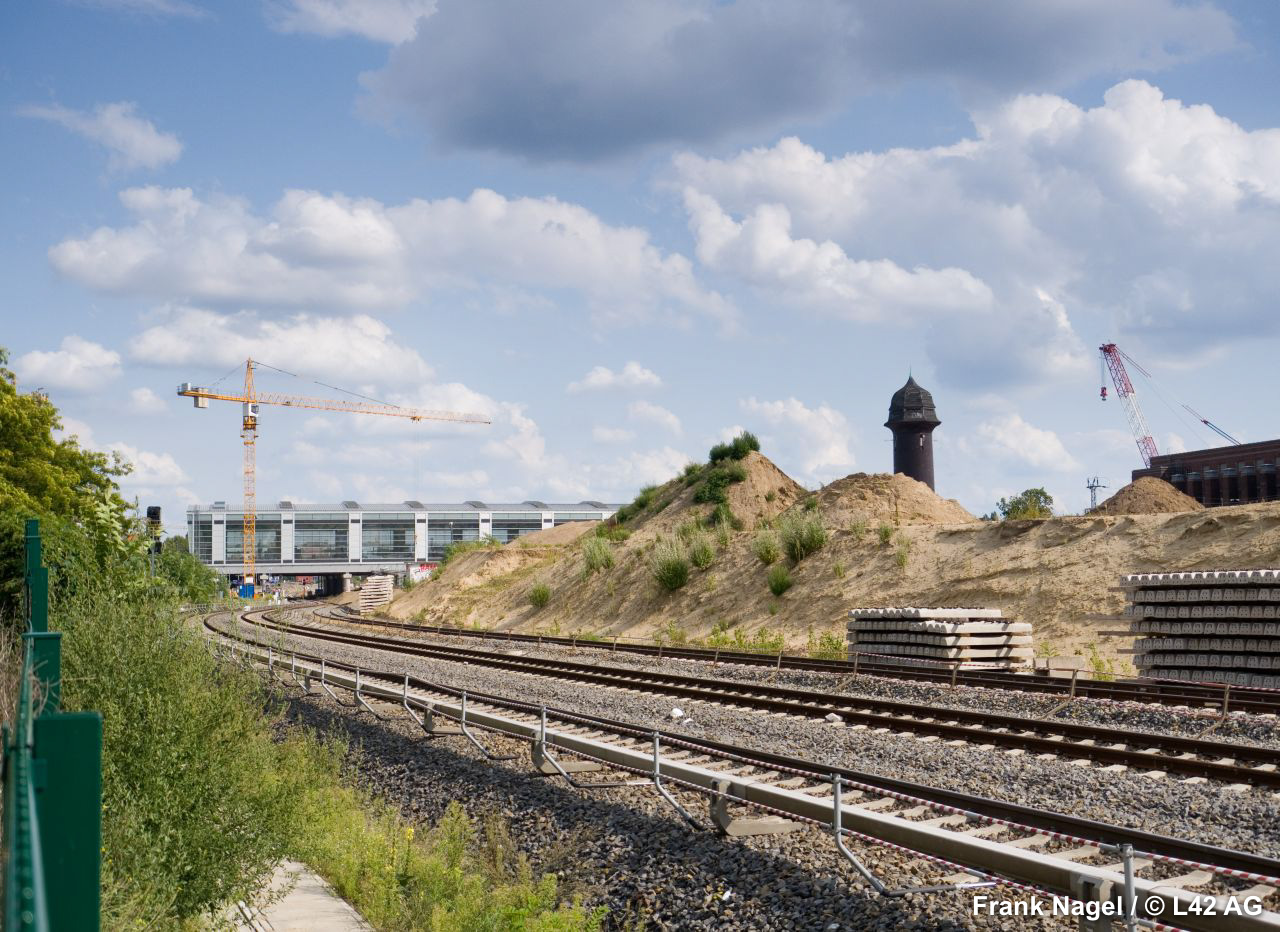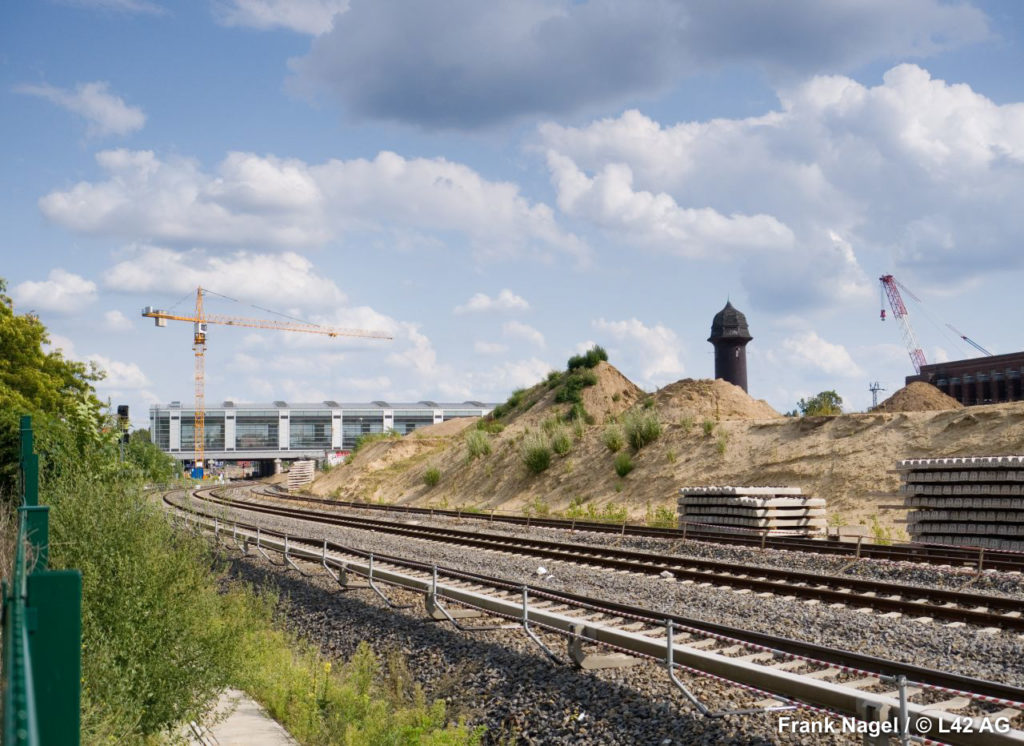
The Ring is that circular stretch of the S-Bahn that, quite logically you might say, encircles the entire semi-central zone of the city. You can travel clockwise on the S41, or counterclockwise on the S42.
Travelling along the entire expanse of the ring takes just a little more than an hour. And it’s not like getting on the U-Bahn: here you can also forget to get off and nothing will happen. Sooner or later you’ll come back to the same place. There inside the train you can see Berlin from a slightly eccentric perspective, in the sense that you see it outside of the center. A trip on the Ring without ever getting off isn’t exactly a sightseeing trip in the classic sense of the term. You won’t see the most beautiful or well-known sites of Berlin, but you will get to understand a lot about the real city, the one which is always in danger of disappearing. In reality, the trip that we shall embark upon covers only a few stops but, as you will see, in anything but conventional places.
First of all, however, we have to decide where we want to get on, and then what direction we’d like to go. The Ring doesn’t really give you any other options, in any event, certainly not any unexpected ones. You can simply step on and let yourself go within the vortex of the circuit and then decide whether you ever want to get off again. Like young couples who don’t know where else to go during a storm until, exhausted, they finally get up to leave.
We’re going to go to a typical station of the Ring – which is to say, a station that is neither infamous nor particularly interesting – with the hope that in the meantime it hasn’t been engulfed by the renewal-wave sweeping the city. Deep down in its soul the Ring is as central as it is marginal, as right as it is left, as West as it is East. In the end, it seems that the Ring wouldn’t really care one way or the other were it not for the fact that here and there it suddenly found itself modernized.
So let’s start at the station of Schöneberg, which is by no means the newest nor the latest. It’s not decrepit either, however, and thus there’s a glimmer of hope that it might stay just like it is for a little while longer: out of the limelight, out of fashion, uninteresting to any guide and therefore all the more authentic. Schöneberg is a nice, dull, iron gray. And though no longer new, it’s not yet rusted; its frosted glass windows are covered by dust; its girders are still made of wood. And it is completely surrounded by weeds. From here we’ll take the Ring east which means we’ll be taking the S42.
The first thing we’ll pass is Schöneberg’s gasometer, which has strangely held out as a piece of history while its cousin in the east – which didn’t bother anyone – was blown up. We can safely affirm that in the West the gasometers and neighborhoods are a lot more stable. Until we have evidence to the contrary, that is.
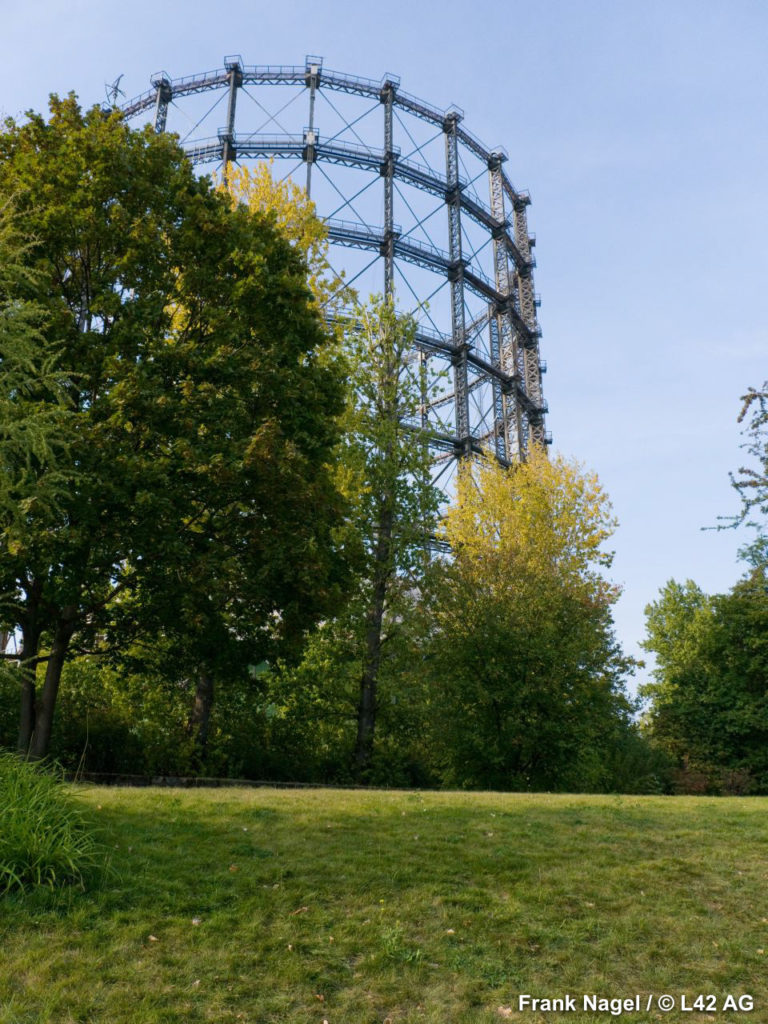
In any event, we’ve already made it to the next station. As of May 2006 Südkreuz is bigger, newer, and more full of light. It used to be called Papestraße and was forever in the modernizers’ sights as it occupies a strategic position: it is at the ring’s southernmost point. Even Albert Speer, the Nazi architect who was in charge of making Berlin the capital of the new Germania, had great ambitions for it. Today Südkreuz is an extremely important junction in the direction of the airport of Schönefeld and hosts one of the largest parking lots in all of Berlin: 2,500 spots. Here and there you’ll notice piles of sand and abandoned freight cars. And though the station is made up of an ocean of tracks, it always feels a bit empty, as if there were other ways of getting to the airport and around the city. And, well, to be honest, there are a lot of other ways.
After passing some old, rusted freight trains off to the side we arrive at the next station, Tempelhof. This station also hasn’t been renovated for the moment, and our attention is immediately caught by something else: before us is an immense stretch of green. When it’s sunny you can see thousands of colored dots pulling kites or darting about it as if on wheels. There really is a lot, a lot of green and, once again, off to the side of the rails, piles of sand.
But we don’t even have time to ask what they’re for before arriving at Hermannstraße and its old buildings.
Neukölln is next and it is incredibly crowded. It’s as if the all the people in the city agreed to meet up right here, and you’d be hard-pressed to find any more culturally and aesthetically diverse place than here.
At Sonnenallee you may notice that the buildings on both the inside and outside of the Ring are old and heavily populated. At one time this was where the factory workers lived and was considered the outskirts of the city. Today, however, little remains of either the factories or their workers and yet it is always busy.
A horizon of fields, gravel, smokestacks, cranes, new buildings, and industrial warehouses stretches out before our eyes at Treptower Park. The iron structure of the old station is painted an intense blue, as if we were on the Aegean Sea. This is still an important inland water point. As we cross over the bridge we can see the Spree sparkling on both sides of us. Boats come and go. The landscape opens up further and we find ourselves at Ostkreuz, which, at least aboveground, doesn’t seem any different than the new section of Südkreuz; down below, however, it is another story.
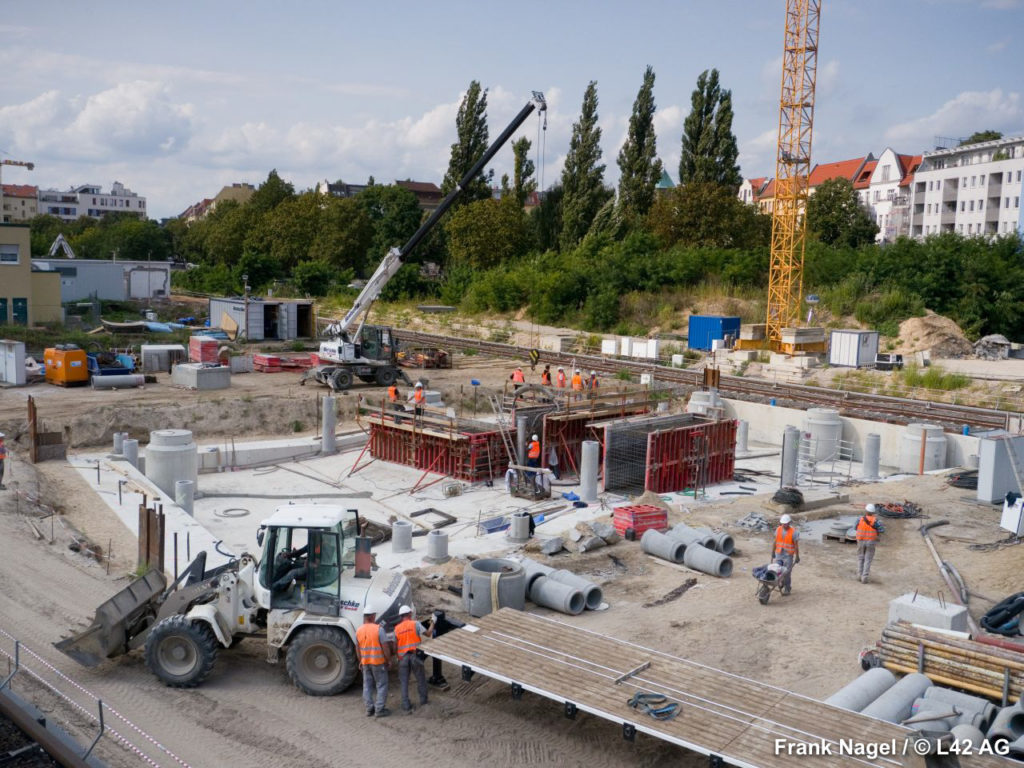
And how. I dig ergo sum you could say about Berlin today: just about every corner seems to have a construction site. Ostkreuz is at the moment the primary railyard for the entire capital. For a second, but only a second, a thought from the English economist John Maynard Keynes comes to mind. He theorized that any public works project could solve the bad luck of a country so long as there was public spending. This idea was illustrated by the famous example of the state which had its unemployed dig a gigantic hole just in order to have them then fill it back up so that they might still receive their salaries. The theory supposed that such willingness to spend would increase consumption because the workers would immediately spend their money in the area around the hole where temporary shops and pubs would have appeared. Now, be that as it may, these holes at Ostkreuz are certainly not Keynesian holes. This station dating from 1933 has been in need of urgent care for quite some time, for it had gotten to the point where it was nicknamed Rostkreuz – “Rost” meaning, you guessed it, “rust”. But who knows if somewhere in the city we won’t find at least one construction site to remind us of old Keynes’ example? Let’s get off here in order to have a look at the state of affairs.
The site here at Ostkreuz is a complex system made up of many different workers involved in many different types of work. We can see tilers finishing up the walkways between tracks (and notice how one of the tracks is still just a furrow without any rails). Steamrollers spread out the sand and then the gravel and then tiles are gently laid down on top with levels. On the other side of the walkway trains are passing by. A second or two beforehand there is the ear-splitting sound of a siren. The first one sounds like a fire alarm and scares you half to death. The second one that goes off not even five minutes later you take in stride. The third one, which comes after ten minutes, you don’t even notice at all.
The violet-colored train now whistling and thundering past is the Warschauer ICC directed to Warsaw. Extremely long rubber tubes containing wires line the sides of the tracks. On the walkways workers are hammering, drilling, uncoiling wires, carrying pails full of sand, digging, measuring, and sawing. What may seem surprising is that a great amount of the work is still done by hand in spite of all the technology available today. The big machines certainly are a help, but when you see the men at work, it doesn’t really seem all that different from the scenes depicted in those old miniatures showing the squads of handworkers in the Middle Ages hard at work constructing the great cathedrals of Europe.
Over in another corner other workers are smoking and talking. At the eastern side of the station one is operating a giant crane by remote which is transporting old cement from the old foundation to a mountain of debris. Others still are filling up the huge containers it moves with shovels. Someone is talking on a mobile phone, while someone else is going to the bathroom. A long iron walkway leading to the tracks has been built over the construction site and when someone is running late, this temporary bridge dances as if there were an earthquake.
But let us now turn around, and get back to our train. If we miss the first one, no problem, we’ll just wait ten minutes and catch the next one.
Passing between both new and old buildings we come to the Frankfurter Allee, at one time the pride of socialism, today another simple station along the Ring.
The tall buildings painted a bright sky-blue, red, green, and yellow by the sprightly Spanish artist Gustavo to our right at Storkower Straße are not just any old Plattenbauten. They are part of the first avant-garde housing projects of the former GDR. To the left there is a shopping center called Kaufland where “kaufen” means “to buy” and “Land” means “earth; land; country”. Taken together, then, it is something like a Consumopolis, a Land of Goods, a Country of Markets.
In any case, between the tall buildings and the shopping center and suspended above the railway tracks is what was once one of the longest bridges in Germany and some even called the ugliest. But even if it that were true, here the ugliness is very interesting. The bridge was constructed in 1937 for hygienic reasons, in other words, to keep the population far away from the nearby slaughterhouse. During the time of the GDR the slaughterhouse employed up to 2,000 people and even furnished West Berlin with its meat. Let’s get off immediately to have a look.
The bridge is indeed rather long and covered like a tunnel and half of it seems rather new and has a reddish border; the other half just seems old and most likely some other district’s responsibility. But, seeing as that we don’t really have much of a choice, let’s go on up to the overpass. The railways below us belong to the S-Bahn, but there are also those belonging to long distance trains. Looking toward the shopping center we see a lot of signs telling us that everything is available for a low price. We are in a place that, were it not for the Fernsehturm (television tower) and the two domes of the Frankfurter Tor, we might define as being in the middle of nowhere. We’re still on the Ring, but at a point from which a strange smudge of almost-confusion emanates.
The people you see walking around have the air of folks who have saved quite a lot of money, but they don’t seem to be celebrating. If Alexanderplatz still manages to make some people feel disoriented, here we are in an out-and-out no-man’s-land, a bit like in all the shopping centers throughout the world, true, but with the addition of an exquisitely contemporary veil of sadness and indetermination straight from out of purgatory itself. If shopping centers by definition have to try to make themselves somehow attractive, to do something to catch the client’s eye, here it seems as if we have reached the ethereal netherworld of commerce. Not only is no one interested in catching anyone else’s eye, but everyone’s eyes are completely listless and indifferent. But this is by no means a criticism or a suggestion that no importance is given here to trade! On the contrary! All the cars are surely ready to be filled up with low-cost booty, but here everything seems to be taking place in a surprisingly hazy air and with solemn, if sensual, indifference. Next to Stadler, which is said to be the largest bicycle store in all of Germany, there is a huge expanse of grass full of daisies and extremely young birch trees. It’s called Hermann-Blankenstein Park, and the iron structure we can see upon it is the skeleton of the former slaughterhouse. We are on Rinderauktionshalle Straße: literally Cattle Auction Street. The name says it all.
Here there is a sickly-sweet smell of factories in the air mixed with currywurst drifting in off the square. But let us go then you and I away from this shopping center (surely one of the most fascinating in the world) and, filled with the void, back to our train.
The people getting on at Landsberger Allee are so completely different from those who would be getting on at Ku’Damm – that avenue of international fashion – that you cannot but wonder at how varied the big city can be.
At Greifswalder Straße there was once a gasometer, but it was demolished in 1984 in order to make room for a 25-hectare (62 acre) park dedicated to Ernst Thälmann. The gasometer, active between 1873 and 1981, had given 108 years of honorable service to the city. Gas was extracted from coal, and then used to illuminate the gas lamps which once lined the streets. From 1908 onward gas began to be extracted from water through a combination of carbon monoxide and water. The transformation of coal, petroleum coke, and other combustibles released cyanide, phenol, hydrogen sulfide, tar, naphthalene, and ammonia into the air. In fact, Albert Speer had also planned a large park here, but, yet again, his plan was interrupted by the war.
Here the GDR made one of its last great decisions. From 1983 to 1986 around 1,300 workers constructed housing for 4,000 inhabitants and a tree was planted for every single one of them. A large area was designated to become a lawn, an artificial lake was made and a cultural center, a swimming pool, and a planetarium and it all was inaugurated on the 100th anniversary of Ernst Thälmann’s birth, April 16, 1986. The entire concept of having living, cultural, and recreation areas within a large park was completely new for the crumbling republic. Citizens loved the Thälmann Park and, on a whole, considered it a real gift.
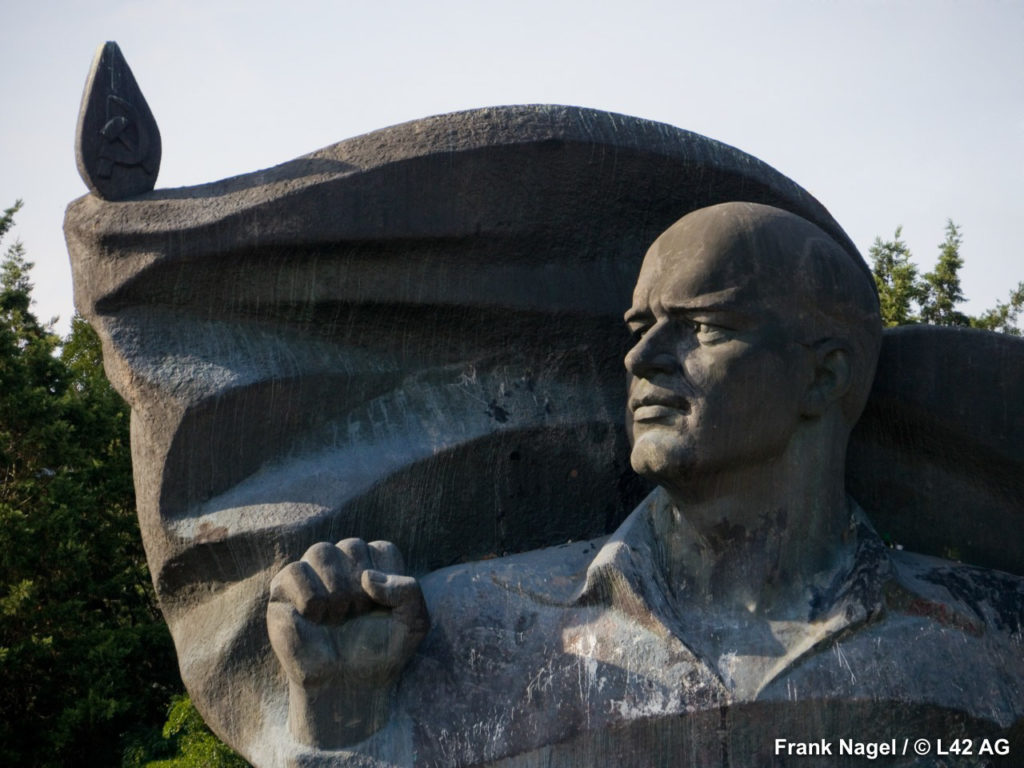
On the day of the park’s inauguration the huge 13 x 15 meter (43 x 49 foot), 50-ton bronze statue of Thälmann standing on an immense block of red Ukrainian granite was unveiled. The statue was the work of a Russian sculptor who was a personal friend of President Honecker, Lew Jefmiowitsch Kerbel. Naturally, famous and esteemed sculptors of the ex-GDR were offended for not having been asked to realize it themselves.
Local residents’ feelings were divided in a particularly delicate moment of the Republic’s history. The removal of the gasometer was met by many with quite a bit of sadness, almost as if its removal had somehow disfigured the landscape. And yet the park was largely seen as a positive addition to the neighborhood and of immediate social value. By that point politicians were largely considered a caste who lacked nothing and had their own living quarters in the country. The distance between those governing and those governed was increasing, as was the public’s irrepressible unhappiness with repression, privation, and lies. The 100th anniversary of Ernst Thälmann’s birth together with the park and all it contained seemed for a moment to slow the relentless train of history down which was threatening to derail from socialism. Ernst Thälmann was a major symbol of resistance and struggle. Once secretary of the Communist Party, he was one of the most important figures of the workers’ movement. After the Nazi’s coming to power he was immediately arrested and held for eleven years in prison before being executed at Buchenwald. On April 24, 1933, he wrote to his wife Rosa:
A man who has a sense of dignity does not renounce his actions. You can become enraged in the hunt for the truth and justice, that much is true, but once they have taken root, it is impossible to suppress them for long…
It is not hard to see how the heads of the GDR sought to instrumentalize the figure of Thälmann in order to gain a bit of time within the slow ruin of the Republic, but the people by then had understood the power of his resistance beyond any reasons of the state. Three years later the Wall came down.
In the 1990s the residents of the neighborhood began to complain about bad smells. The ground had doubtless been cleaned since the time of the gasometer’s removal, but nonetheless high levels of cyanide and phenol were found in the acquifiers. Since 2004 a water purifier has been hard at work in the eastern part of the park cleaning 15 square meters of water an hour from a depth of 30 meters (98 feet).
In 1993 the Senate of Berlin made a proposal to have the gargantuan statue with its raised first removed, but the residents of Prenzlauer Berg were opposed. In 1997 Prenzlauer Berg officially asked its residents if they truly intended to keep the park’s name, and they responded with a resounding “yes.” Thälmann Park was to remain Thälmann Park.
In front of the planetarium today stands a colorful playground of multi-hued sculptures covered in mosaics courtesy of the artist Steffi Bluhm and children from the neighborhood called Sternenspielplatz (Play of the Stars Square). It’s a little park for little children with a large snake, a slide, a ship, and a centaur to climb on, as well as three stars that act as phones. The trains pass by right next to it, but in spring and summer the park is covered by foliage. Kids can thus continuously hear the passing of the train without ever seeing it.
In order to fulfill our role as tourists our next stop shall be Prenzlauer Allee.
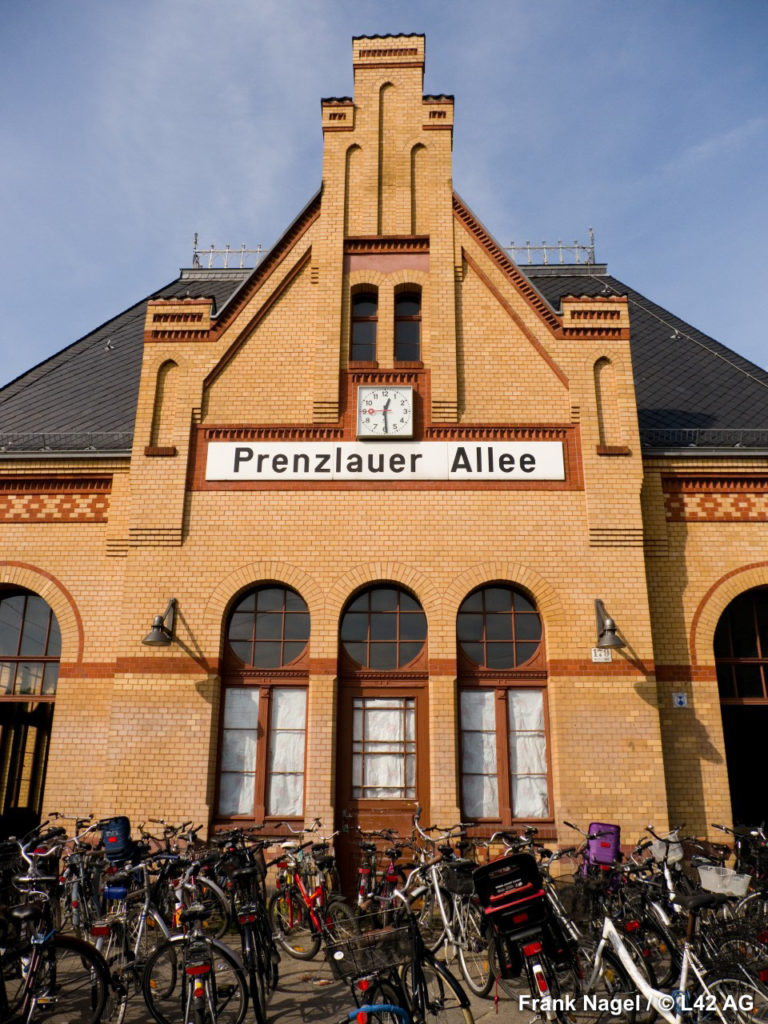
Don’t worry, we won’t walk very far. The little station is all that we’re here to see. The old buildings are for the most part covered up (in spring and summer anyway) by the greenest of leaves, which even decorate the pointed arch of the old tunnel from out of which the train springs. The station’s entrance hall is decorated by tiles in the form of geometric designs, there are lots of rectangular windows, and a huge and heavy corona full of lights hangs down from the beamed ceiling.
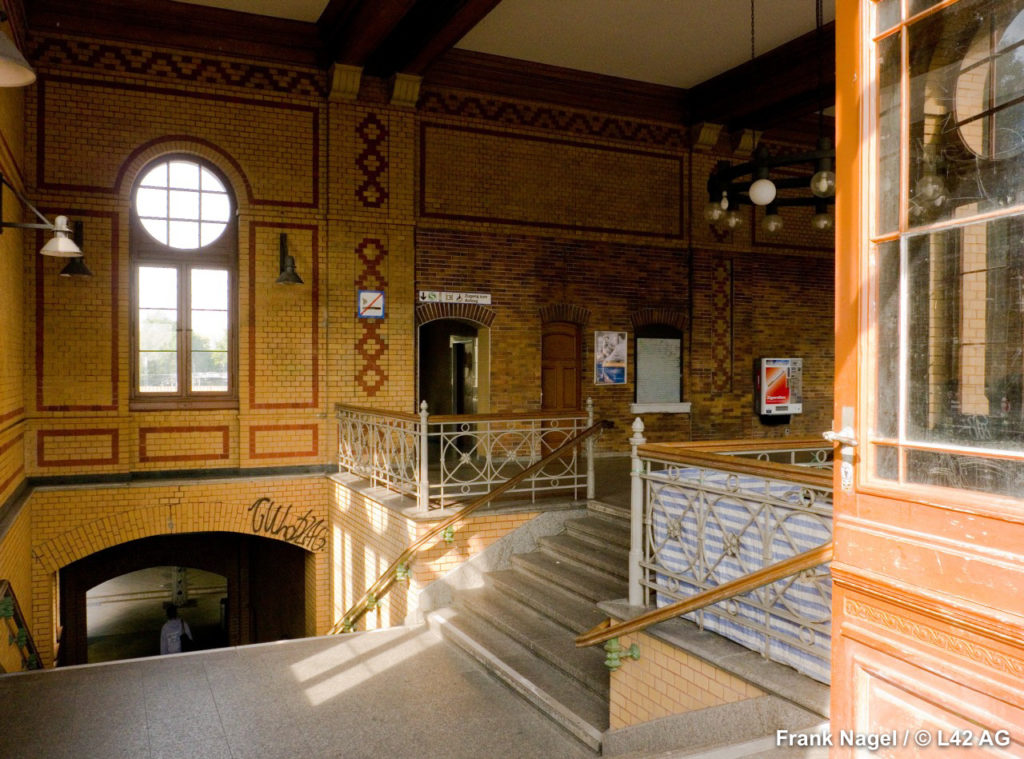
In this part of the station, if necessary, you can buy flowers or cigarettes. We’ll exit through the old door and have a look at the station from outside. It really does seem well taken care of. What a relief to see that it hasn’t become hi-tech, and that we’ve been fortunate enough to enjoy another little piece of history.
Schönhauser Allee’s shopping center, old buildings, and out-of-town trains running alongside is more or less a blur.
More than a station Gesundbrunnen is simply a charmless functional tunnel without any light and the best thing about it is that you’re through it rather quickly and in no time at all once again surrounded by green.
At Wedding there are tons of factories, large supermarkets, towering clouds of coal, and newly constructed buildings chock-full of TV antennas. Maybe they bring the inhabitants a little closer to their former homes.
Westhafen means we are undeniably in the West. The great thing about the Ring is that – just like that – you pass from the East to the West, and vice versa. Be that as it may, what you’ll notice here is that this stop is full of container ships littered with old tools and silos.
Where is that glittering Berlin everyone is always talking about?
We next come to Beusselstraße, which, truth be told, is simply and undeniably ugly. Here we understand in no uncertain terms that the Ring was also conceived of to be a means of transporting goods directly from the factories to the center city. It was to connect the industrial peripheries to the new working-class quarters and to raw materials, finished products, and people. Good old German pragmatism at work, you could say. In reality, however, another, more external ring reserved for the transportation of goods had been planned, but history, as usual, got in the way with its wars, misery, and division and the Ring remained as it was: a multipurpose affair. In the meantime, many factories have transferred their production elsewhere.
Jungfernheide makes you realize that outlying industrial areas have the same features throughout the world. For those of us who not even half an hour ago were commenting on the desolation of former East Berlin the time has come to ask for forgiveness, or at least to say the same about the West.
But wait! What’s this? A river, a lock, and even some garden lots which have been cultivated with lots of love and stuck here between two railway lines and the highway! One great difference you’ll notice between the Ring in the east and the Ring in the west is precisely this: the cars zipping about the highway and ring road together with all the trucks in one long din.
At Westend there really, truly are a lot of cars. Here you can also see the Radio Tower, also known as the Eiffel Tower of Berlin and once proud symbol of the West, which stood in opposition to the TV Tower over in the East at Alexanderplatz, which was mockingly referred to as the Tele-Asparagus, St. Walter (after the President of the German Democratic Republic), and the Revenge of the Pope (as the reflection of a light in the form of a cross could be seen on its sphere). However, today the Radio Tower is almost completely forgotten while its once-derided rival is the worldwide beloved symbol of a reunited Berlin. And so it goes.
Messe Nord/ICC is the next station and people primarily come here twice a year for the two biggest trade fairs: the beloved Grüne Woche (Green Week) dedicated to agriculture; and the IFA, the global trade show for consumer electronics. Otherwise, the modernist and functional exhibition grounds mainly host events of lesser importance.
At Westkreuz the landscape is once again distinctly urban, and there are lots of apartment buildings.
During the time of the Wall Halensee was closed to passengers, but the adjoining rails were heavily used for the transportation of goods. With reunification, passengers returned to the Ring and such transportation definitively ceased.
Hohenzollerndamm: smokestacks and cars. Lots of them.
At Heidelbergplatz a giant mass of buildings has grown right up to the highway, and there are tiny gardens where people can escape on the weekends to grow flowers.
At Bundesplatz we once again find ourselves in the city and the ring road seems to be perennially full of bumper-to-bumper traffic.
At Innsbrucker Platz you can see the flag of the municipality of Schöneberg, and with it we realize that we have arrived where we it was we started: Schöneberg.
But let us get off the Ring now no matter what the weather is like! We’ll take the opportunity to say goodbye to the couple who had sat down next to us, but who, in any event, didn’t notice us at all, and we’ll jump back into the city as tourists.
Translated by Alexander Booth
